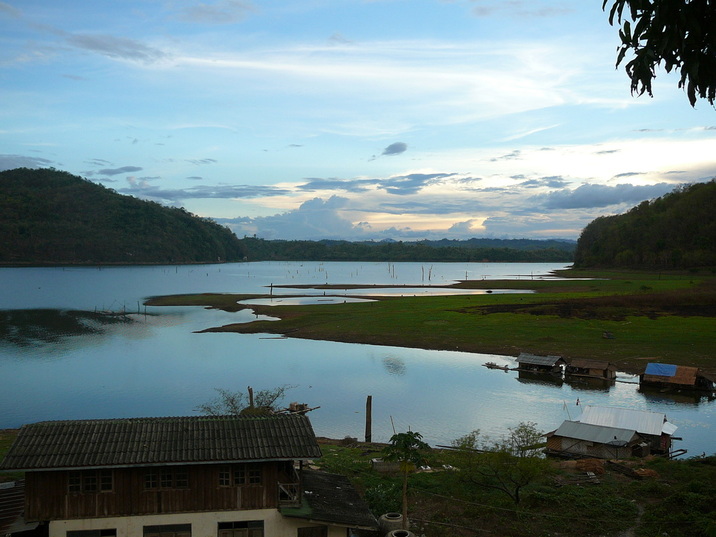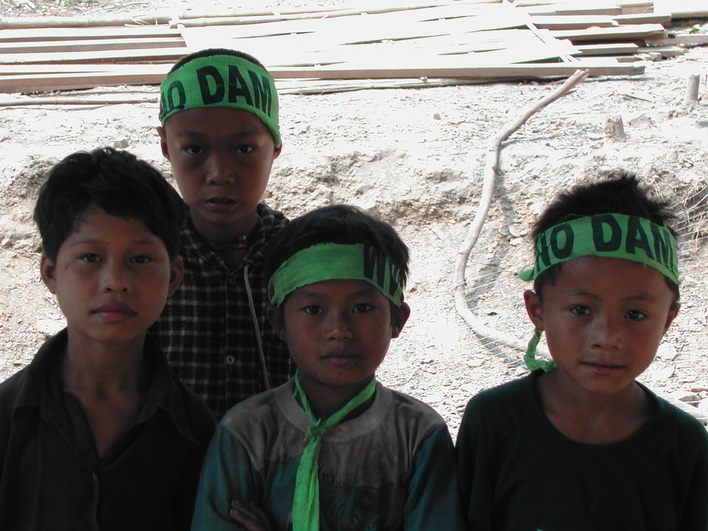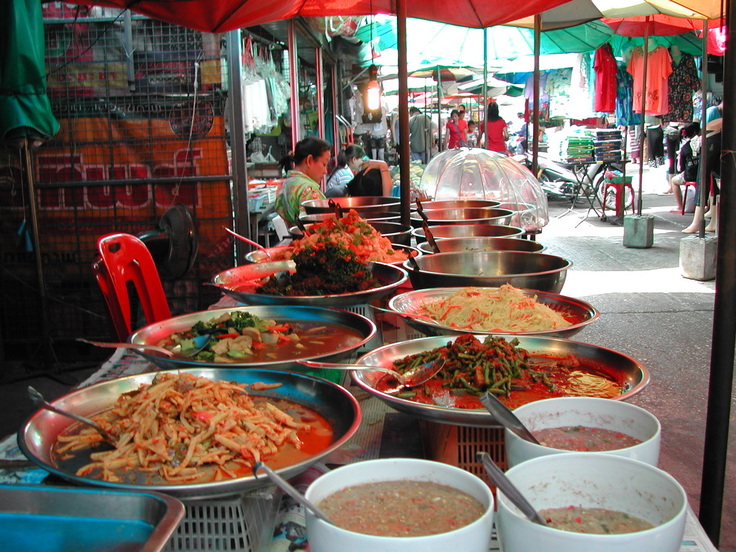 The lake near Sangklaburi
The lake near Sangklaburi The BGET boys and I arrived in Sangklaburi on Monday after a grueling twelve hour journey by pick up truck. Although it was all on highway, I was trapped in the back of the “King Cab”, tiny seats behind the driver and passenger. I think Toyota is overstating its case calling it a King Cab, “Princeling Cab” or “Fourth-in-Line for the Throne Cab” would be more apt! Plus the seats had no padding left and the shock absorbers were shot. In short, I suffered the whole way from a painful rear end and frequent loss of blood flow to that area. This brings me to my main gripe about Thailand – the hardness of the sitting and sleeping surfaces. All the chairs are made from hardwood, and the hardwood around here is the defining standard by which all others are measured. The mattresses are of horsehair or some such unforgiving substance. When I stagger from the truck, blood circulation not yet fully restored, I am welcomed by the sight of the restaurant table and benches all crafted from Terrazzo, which is concrete with stones embedded in it, ground flat and polished to a gleaming surface of diamond hardness. When staying in the village or other guest situation, we sleep on the hardwood floor with only a thin raffia mat to keep the sleeping bag clean, – padding value zero! Everyone else is apparently cool about this appalling oversight in Thai culture, which is otherwise very civilized. I have heard that there is a cushion somewhere in South East Asia, but for me, this is now taking on the status of a Creation Myth – “ Once upon a time, our ancestors used to live happily on top of a big plush cushion, but then one day someone complained that it was not soft enough, so they were thrown off and we have been condemned to sit and sleep on rock-hard surfaces ever since”. But if a bruised arse is the highest cost of the transforming experiences I’m having, then I pay it gladly.
We gave the solar training on Tuesday and Wednesday to the Mon Women’s Organization. There were six women and one man in the class, including our translator. Again I find myself in a multi-language soup, which is fun, but always leaves me wondering just how much the information got changed as it made its way from English to Thai, thence to Mon or Karen. In my worse nightmares, what started its life as, “Never, ever get the battery acid in your eyes or mouth”, ends up as “the battery acid is a little caustic, but it really brightens up your teeth”. I taught in English, that most of the women understood, with additional clarifications in Mon. The BGET boys taught in Thai, which was translated wholesale into Mon. The entire training was one long, love-fest of good feelings, frequently punctuated by gales of laughter. This is the way the Mon people like to have their interpersonal relations. I want to cry when I think that there is very large group of well-armed thugs, just over the border, who have a stated policy of repression and genocide against such sweet people.
The Mon are one of the original peoples of South East Asia, pre-dating the arrival of the majority Burmans. The Mon brought Theravada Buddhism, which is now the predominant religion in all of the SE Asian countries. They are physically slight, extremely handsome in a refined, delicate way. The Mon are originally a lowland culture, like the Thai, in contrast to the other ethnic minorities in Burma, like the Karen, Karenni, Kachin and Chin, who have traditionally lived the mountains, since their arrival from points north. Mon language is written in a script that has since been adopted and adapted by the Burmese language. In short, Mon culture is very ancient and sophisticated, originally dominating most of present day Burma, yet today, it is fighting a rear guard action, just to preserve its language. Like the Karen, the Mon have an armed resistance against the SPDC. But also, like the Karen, they are riven by factional splits, that the SPDC exploits and which reduce their effective fighting force.
The MWO have branch office in Sangkla, where I am staying, which is a base for education and communications. Teams of Mon youth come here to do courses in English, Journalism and Democratic Rights among other subjects. It was very inspiring to hear her talk the politicization of the Mon youth, and their optimism for a positive democratic future. When they cross the border back into Burma, they have to be careful not to carry any incriminating papers, as they will be searched by the border guards. Like Leo Ferre, the French poet said in the 70s, “Rien dans la main, rien dans la poche, tout dans la tranche!” There’s nothing in my hand, nothing in my pocket, it’s all in my mind! (Where you can’t get at it!)
There are many Mon people in Sangklaburi, some were born here and have Thai papers and full rights. Many others were born in Burma and have almost no rights, they are “unrecognized refugees”. In contrast, the Mon in Sangklaburi, do not fear arrest, but they cannot leave the immediate district without a travel document, even to go to the regional capital, 2 hours away by bus. The document contains the destination address, the number in the party and the hour of expiration. The Mon Women’s Organization and similar groups are tolerated in Thailand as long as they do not agitate, hold demonstrations or publish subversive material. The Mon are not trapped in a camp like Mae La, but they are exploited, forced to accept low wages and they cannot own a house, a car or get a driver’s license, not even a business license.
Sangklaburi is quite a contrast to our beloved Mae Sot, being much smaller and located on a gorgeous lake in a much more tropical zone. The lake is man made, formed by a hydro-electric dam, commissioned by the King about twenty years ago. Despite that, it looks very natural and provides food and long-tail boat transportation for the local community. The town is spread out and only has one wide main street, whereas other streets run down peninsular ridges that drop into the lake. There is a Mon side and a Thai side, connected by a modern road bridge and also, the longest wooden bridge in Thailand. The road virtually ends here, but Three Pagoda Pass, a border crossing point to Burma, is just 10kms away. The pass was held jointly by the Mon and Karen rebel armies until 1990, when it was over-run by Burmese forces. Like Mae Sot, Sangkla, has it’s share of political intrigue, spies and the occasional murder, but it’s not the growth industry that it is in the gritty old border queen!
The area is surrounded by jagged, forested mountains that march off into the distance, in ridges of subtly lighter and lighter hues. It’s picture perfect. All the more poignant, given the mind-bending situation that the Mon are in, when one considers that the Thai-Burma Railway, built by the Japanese using Allied and Burmese slave labor, ran through Kanchanaburi, the regional capital about 100kms away. This area, gorgeous as it is, has been contested since the days of the Mon/Burman empires, and before. As always, the ordinary person, who just wants to raise their family and live a peaceful life, is caught in the middle and ends up paying the highest price.
I hope to come back here next year, but I’ll have to get used the humidity, which is a good deal higher than in Mae Sot. As I write, there’s a tropical storm just above, trying to decide whether to drop it on us, or move on and plaster somewhere else. But that’s why it’s so green, isn’t it?



 RSS Feed
RSS Feed